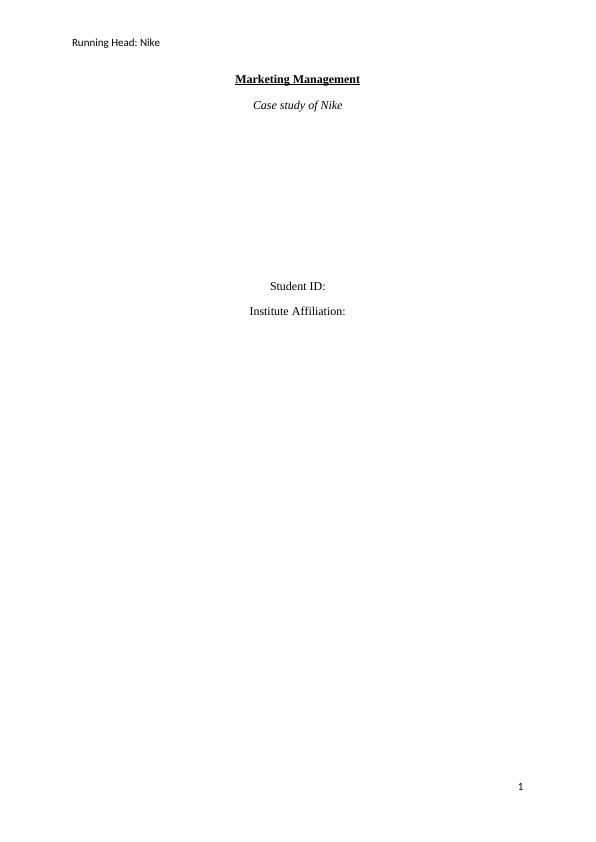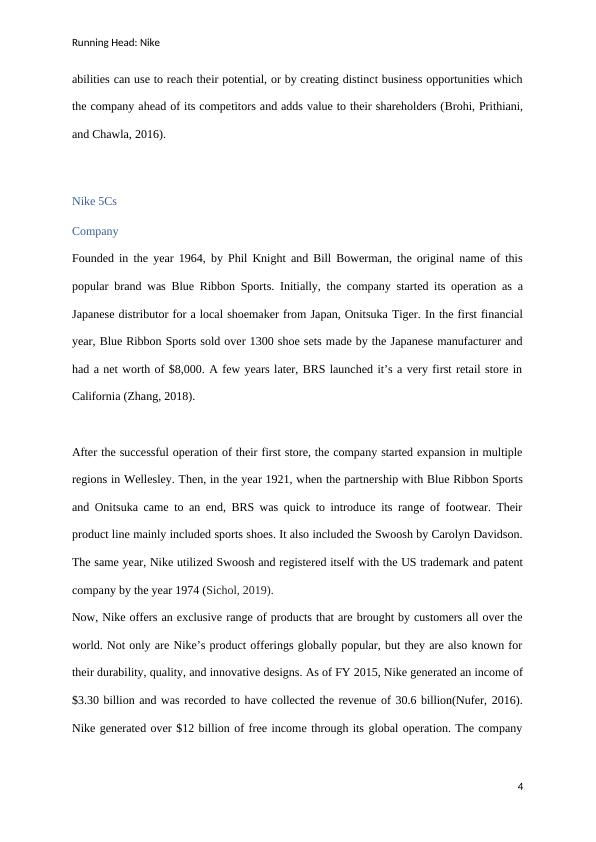Marketing Management: Case study of Nike
Added on 2023-03-23
18 Pages4472 Words59 Views
Running Head: Nike
Marketing Management
Case study of Nike
Student ID:
Institute Affiliation:
1
Marketing Management
Case study of Nike
Student ID:
Institute Affiliation:
1

Running Head: Nike
Table of Contents
Nike: Company Overview..........................................................................................................3
Nike 5Cs.....................................................................................................................................4
Company................................................................................................................................4
Customers...............................................................................................................................5
Collaborators..........................................................................................................................6
Competitors............................................................................................................................6
Context...................................................................................................................................7
Market Research:.......................................................................................................................8
Customer Demands:...............................................................................................................8
Competitor’s Moves:..............................................................................................................9
Context Change:.....................................................................................................................9
Marketing Strategy for Nike:...................................................................................................10
Objectives of Marketing Strategy:.......................................................................................10
Segmentation, Targeting and Positioning............................................................................10
Nike Market Segmentation:.............................................................................................10
Target Marketing..............................................................................................................11
Positioning:......................................................................................................................12
Marketing Mix Strategy: 4Ps...................................................................................................12
Product:................................................................................................................................12
Pricing:.................................................................................................................................12
Place:....................................................................................................................................13
Promotions:..........................................................................................................................13
Conclusion................................................................................................................................15
References................................................................................................................................16
2
Table of Contents
Nike: Company Overview..........................................................................................................3
Nike 5Cs.....................................................................................................................................4
Company................................................................................................................................4
Customers...............................................................................................................................5
Collaborators..........................................................................................................................6
Competitors............................................................................................................................6
Context...................................................................................................................................7
Market Research:.......................................................................................................................8
Customer Demands:...............................................................................................................8
Competitor’s Moves:..............................................................................................................9
Context Change:.....................................................................................................................9
Marketing Strategy for Nike:...................................................................................................10
Objectives of Marketing Strategy:.......................................................................................10
Segmentation, Targeting and Positioning............................................................................10
Nike Market Segmentation:.............................................................................................10
Target Marketing..............................................................................................................11
Positioning:......................................................................................................................12
Marketing Mix Strategy: 4Ps...................................................................................................12
Product:................................................................................................................................12
Pricing:.................................................................................................................................12
Place:....................................................................................................................................13
Promotions:..........................................................................................................................13
Conclusion................................................................................................................................15
References................................................................................................................................16
2

Running Head: Nike
Nike: Company Overview
The company Nike Inc. is all about providing innovative products and gears for athletes. It’s
a leading sports apparel and footwear company. The brand mainly targets athletes by selling
related products like sporting equipment, clothes, and shoes. The footwear and athlete
industry are characterized by increased competitive rivalry and it is highly fragmented, and
yet, Nike holds a very strong position. Over the last ten years, Nike the sporting goods
industry has witnessed a consistent growth because of the modest increase in the sports
participation ratio. There has been a continuous demand for sporting goods, which has
created a perfect opportunity for companies like Nike (Ryan, 2016).
The top players of the sports goods industry are forecasted to observe 20% more revenue by
the year 2025(Araujo, Caldwell, and DeFanti, 2018). The market for sports goods like
footwear has been on an increase and this industry is projected to witness sales of more than
89 billion in the U.S in the year 2020. That explains why Nike has been using vertical
operations for implementing new technologies and to examine the latest customer trend
(Baena, 2017).
Nike had tremendous growth all over the United States. Not only did it make itself one of the
leading brands of the U.S athletic market but also covered 50% of the market share with a
span of ten years. The company then made a great deal with Widen Kennedy and started
investing in multiple marketing mediums to reach the target buyers and spread awareness
about their products. By the year 1980s, Nike had already established brand recognition by
making the association of sports and athletes with its product offerings (Araujo, Caldwell,
and DeFanti, 2018).
For Nike, the mission has been to bring both innovation and inspiration to all the sports
players and athletes in the world. Nike’s chief vision is to continue its legacy of creative
thinking. They strive to do this by either developing unique products which athletes of all
3
Nike: Company Overview
The company Nike Inc. is all about providing innovative products and gears for athletes. It’s
a leading sports apparel and footwear company. The brand mainly targets athletes by selling
related products like sporting equipment, clothes, and shoes. The footwear and athlete
industry are characterized by increased competitive rivalry and it is highly fragmented, and
yet, Nike holds a very strong position. Over the last ten years, Nike the sporting goods
industry has witnessed a consistent growth because of the modest increase in the sports
participation ratio. There has been a continuous demand for sporting goods, which has
created a perfect opportunity for companies like Nike (Ryan, 2016).
The top players of the sports goods industry are forecasted to observe 20% more revenue by
the year 2025(Araujo, Caldwell, and DeFanti, 2018). The market for sports goods like
footwear has been on an increase and this industry is projected to witness sales of more than
89 billion in the U.S in the year 2020. That explains why Nike has been using vertical
operations for implementing new technologies and to examine the latest customer trend
(Baena, 2017).
Nike had tremendous growth all over the United States. Not only did it make itself one of the
leading brands of the U.S athletic market but also covered 50% of the market share with a
span of ten years. The company then made a great deal with Widen Kennedy and started
investing in multiple marketing mediums to reach the target buyers and spread awareness
about their products. By the year 1980s, Nike had already established brand recognition by
making the association of sports and athletes with its product offerings (Araujo, Caldwell,
and DeFanti, 2018).
For Nike, the mission has been to bring both innovation and inspiration to all the sports
players and athletes in the world. Nike’s chief vision is to continue its legacy of creative
thinking. They strive to do this by either developing unique products which athletes of all
3

Running Head: Nike
abilities can use to reach their potential, or by creating distinct business opportunities which
the company ahead of its competitors and adds value to their shareholders (Brohi, Prithiani,
and Chawla, 2016).
Nike 5Cs
Company
Founded in the year 1964, by Phil Knight and Bill Bowerman, the original name of this
popular brand was Blue Ribbon Sports. Initially, the company started its operation as a
Japanese distributor for a local shoemaker from Japan, Onitsuka Tiger. In the first financial
year, Blue Ribbon Sports sold over 1300 shoe sets made by the Japanese manufacturer and
had a net worth of $8,000. A few years later, BRS launched it’s a very first retail store in
California (Zhang, 2018).
After the successful operation of their first store, the company started expansion in multiple
regions in Wellesley. Then, in the year 1921, when the partnership with Blue Ribbon Sports
and Onitsuka came to an end, BRS was quick to introduce its range of footwear. Their
product line mainly included sports shoes. It also included the Swoosh by Carolyn Davidson.
The same year, Nike utilized Swoosh and registered itself with the US trademark and patent
company by the year 1974 (Sichol, 2019).
Now, Nike offers an exclusive range of products that are brought by customers all over the
world. Not only are Nike’s product offerings globally popular, but they are also known for
their durability, quality, and innovative designs. As of FY 2015, Nike generated an income of
$3.30 billion and was recorded to have collected the revenue of 30.6 billion(Nufer, 2016).
Nike generated over $12 billion of free income through its global operation. The company
4
abilities can use to reach their potential, or by creating distinct business opportunities which
the company ahead of its competitors and adds value to their shareholders (Brohi, Prithiani,
and Chawla, 2016).
Nike 5Cs
Company
Founded in the year 1964, by Phil Knight and Bill Bowerman, the original name of this
popular brand was Blue Ribbon Sports. Initially, the company started its operation as a
Japanese distributor for a local shoemaker from Japan, Onitsuka Tiger. In the first financial
year, Blue Ribbon Sports sold over 1300 shoe sets made by the Japanese manufacturer and
had a net worth of $8,000. A few years later, BRS launched it’s a very first retail store in
California (Zhang, 2018).
After the successful operation of their first store, the company started expansion in multiple
regions in Wellesley. Then, in the year 1921, when the partnership with Blue Ribbon Sports
and Onitsuka came to an end, BRS was quick to introduce its range of footwear. Their
product line mainly included sports shoes. It also included the Swoosh by Carolyn Davidson.
The same year, Nike utilized Swoosh and registered itself with the US trademark and patent
company by the year 1974 (Sichol, 2019).
Now, Nike offers an exclusive range of products that are brought by customers all over the
world. Not only are Nike’s product offerings globally popular, but they are also known for
their durability, quality, and innovative designs. As of FY 2015, Nike generated an income of
$3.30 billion and was recorded to have collected the revenue of 30.6 billion(Nufer, 2016).
Nike generated over $12 billion of free income through its global operation. The company
4

End of preview
Want to access all the pages? Upload your documents or become a member.
Related Documents
Executive Summary Research 2022lg...
|10
|2502
|13
The Market Analysis of NIKE Reportlg...
|21
|4636
|70
Sales Strategy and Management Plan for Nike Inc.lg...
|16
|4220
|465
Report on Marketing Strategies of Event Management of Nikelg...
|14
|3416
|99
Marketing Management for Nikelg...
|22
|3974
|471
Principles and Practice of Marketing: Marketing Planlg...
|13
|3142
|36
